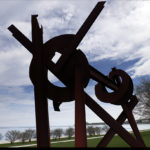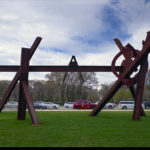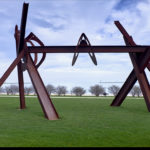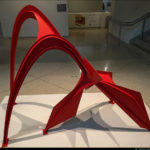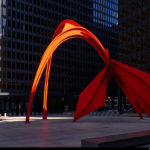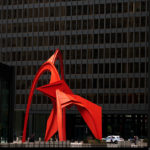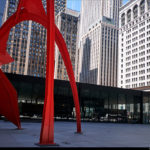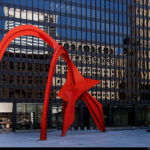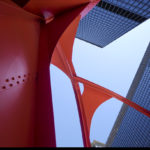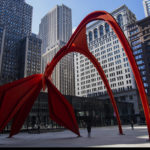You may recall from some of my other posts, I’m a creature of habit, revisiting places and locations, sometimes just to see familiar works or new exhibitions in favorite galleries. On more than one occasion I’ve had that sense of déjà vu, when in a specific location, coming to the realization that, oh yes, I’ve been in this place, seeing a different exhibition, sometimes in a reconfigured gallery, usually leading to an enhanced or new appreciation/understanding. Then there are intentional visits to search out specific works of art, to see how they look, sometimes with years between viewings, with layers of experience between visits added to the mix.
During our walks in Chicago, we made several visits to see specific outdoor works, especially Magma by Mark di Suvero and Flamingo by Alexander Calder. Even when you see works repeatedly, over a period of years, and think you know them, one can always see something new, gain a better understanding or appreciation, perhaps even see a subtle detail overlooked.
Embedded in my memory is the first time seeing a sculpture by Mark di Suvero; the scale of the works was such that the gallery could only accommodate, as I recall, two works, and one was so large that Virginia Dwan had a hole cut in the ceiling for the installation. It was the first time I’d encountered an artwork that invited public participation, beyond viewing, by laying on the platform suspended from cables that provided the viewer with a new view and experience; one became a participant in the artwork while the platform moved, swinging gently beneath the beams.
Since that initial viewing, I’ve seen di Suvero’s works at various locations, Storm King, the grouping of several works at Crissy Field in San Francisco in 2013, and I had the good fortune to work for many years on a campus where Mark created and installed For Handel. When he was still working in Northern California we visited his work site. We had the unique opportunity to ride in the cherry picker, up into the heart of a work in progress as Mark showed us how he designs the joints that hold the massive beams together (and allows them to be disassembled and transported to other locations). Seeing Magma installed in a new location, it looked fresh and enlivened the space around it.
During one of our recent visits to the Art institute, we left via the exit near Alexander Calder’s model for Flamingo, as we planned to walk along the lake to see Mark di Suvero’s sculpture that we had seen a few days earlier. Calder’s Flamingo is the model for the outdoor sculpture on the Federal Plaza campus, designed by Mies Van Der Rohe. I’m always reminded of the day some years ago, exploring the museum with family, Steve, Hilary, and Spencer, when after a few hours we came upon the model for Flamingo, and then ten-year-old Spencer exclaimed, “Finally, something cool!” And I thought to myself, a young man with a good eye.
During this Chicago trip, we made several visits to di Suvero’s Magma and Calder’s Flamingo as we walked in the city. Seeing these two works, over several days, in different light, we were reminded just how important and exciting it is to see art works in a variety of conditions, different times of day, in direct sun or diffused light, at night, and in different seasons, and in the case of Magma, in another location. It makes one realize just how complex and truly magnificent these works are. At times like these one comes to understand that these works transcend being an object or thing and become, in part, because of their beauty, intent, and scale, monumental experiences.
- Magma, 2008-12
- Magma, 2008-12
- Magma, 2008-12
- Flamingo, 1973, Art Institute of Chicago
- Flamingo, 1973
- Flamingo, 1973
- Flamingo, 1973
- Flamingo, 1973
- Flamingo, 1973
- Flamingo, 1973
- Flamingo, 1973
- Flamingo, 1973
- Flamingo, 1973


